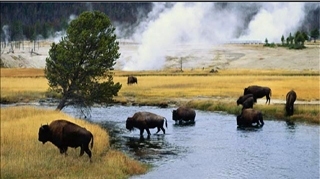|
Irrigation Electricity
Introduction
Stages of development Ditch - Well
- Pivot
Irrigation closely tied to
electricity in Buffalo County
A Kearney Canal (construction)
1873 May have been talk of it, no
records.
1875 Definite discussions, possibly
because of drought and grasshoppers in mid-70s.
1876, January Group appeared before
the County Board asking for survey of a route from 12 miles west of Kearney
to the bluffs north of Kearney. Survey done and apparently dropped.
1881, April New Kearney Board of
Trade [C of C] discussed a canal for water power for manufacturing.
Apparently vigorous discussion followed.
Canal was to be for:
Water power
Fire protection
Irrigation
[Electricity production came after completion]
1882, fall Kearney Canal and Water
Supply Company formed & construction began
1883, spring & summer Construction
continued, did 12 miles. $$ gone.
1885, July George W Frank bought
controlling interest in the Kearney Canal and Water Supply Company.
Work resumed in the fall
1886, August Canal completed
1888, April Canal began producing
electricity
B. REA
1929 In all of Nebraska only 5,278
farmers had electricity. Must have had generators because municipalities
could not sell electricity beyond city limits,
1930, November State ballot issue
past allowing cities to sell electricity 25 miles beyond city limits.
Private power groups were against.
500
Irrigation wells in Buffalo County in this year. Before electricity, farmers
with pump irrigation ran their pumps with tractors or some other gas-powered
engine belted to the pump.
1931-1936 Electricity did not
spread to rural areas
1. Cities
owning generating plants were unable or unwilling to finance rural projects;
additional generating capacity and new equipment was necessary
2. The
depression
3. Rates
charged by private power companies were so high the small farmer could never
afford it.
1933 Federal legislation allowed
for the creation of hydroelectric districts
3 in
Nebraska: Loup River, Platte Valley [which included Buffalo County] and
Central Nebraska (Tri-County).
1935, May President Roosevelt
created the Rural Electrification Administration by executive order.
1935, November Buffalo County
farmers had a conference where they planned a temporary rural
electrification organization & discussed pump irrigation.
1936 Rural Electrification Act was
adopted
1. Authorized
a loan program to co-operatives and public power districts for construction
of rural lines.
2. To
encourage the first customers, installation loans were made to individual
farmers.
3. Not
welcomed by the private power companies
4. Not all
farmers endorsed the program. a) Republicans who didn't want anything to do
with a New Deal proposition, b) others felt that electricity generated by
water was inferior to that generated by steam.
1937, January 23, the first REA board
in Buffalo County was organized called the Buffalo County Public Power
District [later merged with Dawson County Public Power District]
1. The first
construction contract covered 142 miles of line and 328 farmsteads with an
estimated 202 irrigation wells.
2. First
phase Elm Creek east to Gibbon
3. Second
phase east to the Hall County line. Included Gibbon, Shelton & Sharon
townships
1938, May 15 Setting of the first
pole on the John Hammans farm near Gibbon. The first section of lines was
energized in December, 1938.
1939, June Charles A. Palmer of
North Platte was appointed project superintendent in the Kearney office. He
headed the REA in Kearney from that time until his retirement. It can be
said without a doubt that the success and achievements of REA in Buffalo
County were in a large part due to Charlie's guidance and supervision.
1939, August 8 A meeting to help
members and prospective members of the Buffalo County Public Power District
plan their wiring was to be held in Gibbon.
REA loans
were obtained to pay for the lines and farmers could get loans to wire their
homes.
Farmers were
urged to get their wiring contracts as soon as possible because lines would
not be built to farms who were not wired or did not have wiring contracts.
People had to
be convinced electricity was a good thing:
Electricity is a servant, make it work for you.
Then baking days won't be so hot, or washdays be so blue.
Your cows will be contented, with a milker fine and bright.
The kids will like the music, from the radio at night.
Your feed will be ground easily, your baby chicks kept warm.
The whole family will be happy, with electricity on the farm.
--Author Unknown
C. Pump Irrigation
Major incentive for development of
REA
1939, March 16 The first water for
irrigation was pumped with REA power (at the McConnell Bros. well)
1940, July 30 (16 ½ mo. later)
100th pump was installed on the Warren Reynolds farm east of Kearney.
Buffalo County farmers felt so good about this that they held a celebration
at the Reynolds farm
.Over 200 people attended. REA officials spoke, and a
transcription of the ceremony was broadcast over KGFW Radio, recording the
hum of the pump. [photo in BCHS Archives]
Early 50s, most of the farms in
Buffalo County had REA service. The last portion of the county was the
northwest section, where a sub-station at Miller served remaining portions
of Sartoria, Armada, Scott and Harrison townships.
1950s Howard Mefford wrote about
IH machinery business - Irrigation became a major player in the productivity
of the area and the resulting increase in crop yield demanded more advanced
machines with different methods and larger capacities.
D. Margaret Palmers Scrapbook [located in BCHS Archives]
Apr-May 1940 Survey of use of electrical appliances used in first
electric district in first 13 months of operation. 90 consumers reported
using
iron 91%
radio 88.5%
washing machine 85%
refrigerator 40%
poultry lighting were becoming increasingly popular
farm wives beginning to use electric brooders
REA Newsletter
First issue April, 1940 article about
use of radio in dairy barns
July, 1940 article about moths & decision to light school
|

